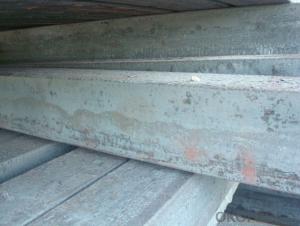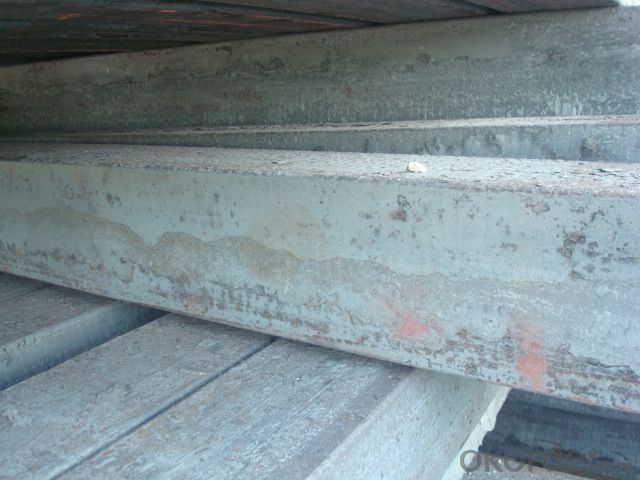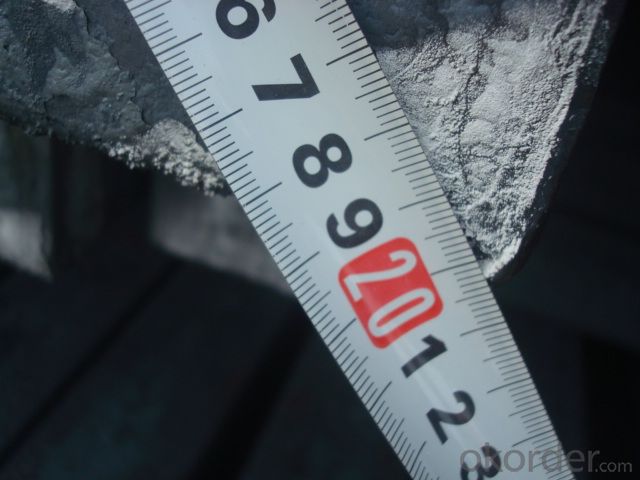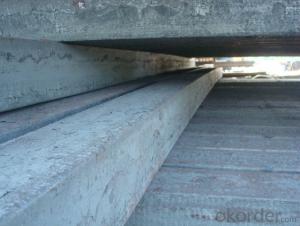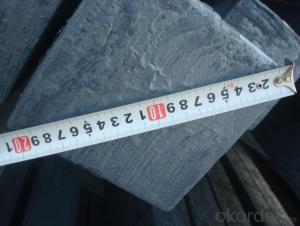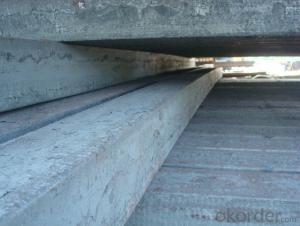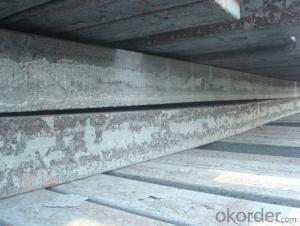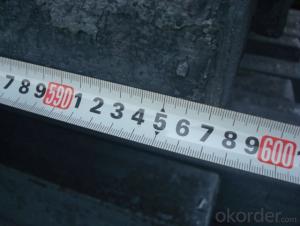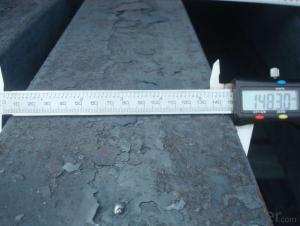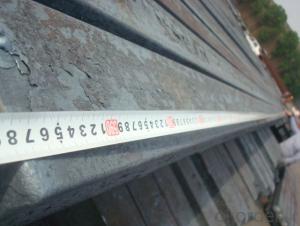Continue Casting Steel Bloom Made by Blast Furnace
- Loading Port:
- Tianjin
- Payment Terms:
- TT OR LC
- Min Order Qty:
- 1000 m.t.
- Supply Capability:
- 100000 m.t./month
OKorder Service Pledge
OKorder Financial Service
You Might Also Like
Continue Casting Steel Bloom Made by Blast Furnace
1.Structure of Continue Casting Steel Bloom Made by Blast Furnace
Continue Casting Steel Bloom Made by Blast Furnaceis the raw material of all kinds of steel products.For example, Billet section of square, round, flat, rectangular and abnormity, etc Several, mainly related to shape of rolled products. Simple rolled section steel, choose cross section of square billet or rectangular billet. rolling The sector products such as flat steel, Angle steel, select the rectangular billet or slab. There are diffirents kinds of the spec. for the steel billet, in the past, Many steel mill produce the steel billet by Electrice furnace, but now most of the steel billet manufactured by blast furnace.
2.Main Features of Continue Casting Steel Bloom Made by Blast Furnace
Continue Casting Steel Bloom by Blast Furnace section size is normally includes 120*120,130*130,150*150,160*160,165*165 and so on. And also includes the retangular size, it depands on the usage of the steel billet. simplify the stock management of workshop.
3. Continue Casting Steel Bloom Made by Blast Furnace Images
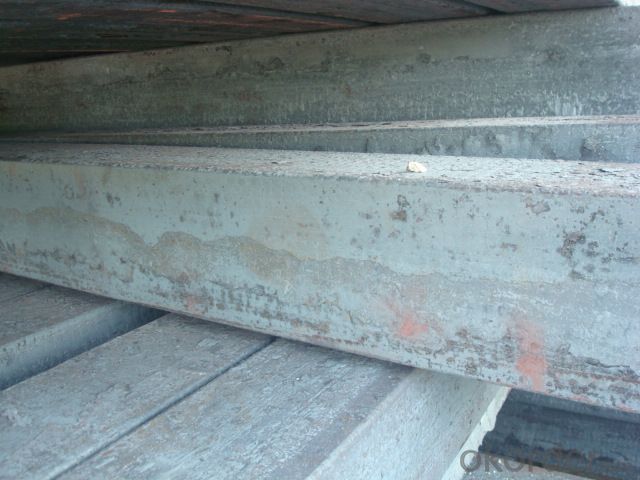
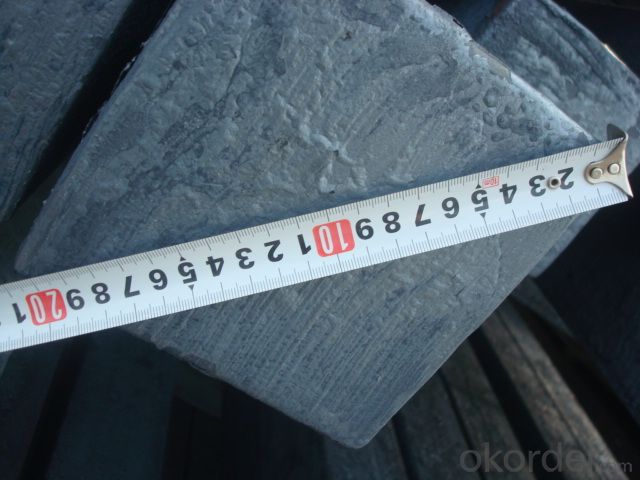
4. Continue Casting Steel Bloom Made by Blast Furnace Specification
Continue Casting Steel Bloom by Blast Furnace rolled steel, after processing can be used for mechanical parts, forging parts, processing all kinds of steel, steel Q345B channel steel, wire rod is the role of the billet. Steel billet is used in the production of semi-finished products, generally cannot be used directly for the society. Steel billets and steel are strictly divided into standard, cannot decide to whether the business enterprise of the final product, and according to unified standards to perform the whole society. Typically, billet and the steel is relatively easy to distinguish, but for some steel billet, and have the same specification and same steel purposes (such as rolling tube billet), whether can be used for other industries, whether through steel processing process, whether through a finished product rolling mill processing to distinguish
Material standard The editor Range of thickness: 150-240 - mm + / - 5 mm width range: 880-1530 - mm + / - 20 mm Length: 3700-10000 - mm + / - 500 - mm Cross-sectional size: 64 * 64; 82 * 82; 98 * 98; 124 * 124; 120 * 150; 152 * 164; 152 * 170 mm Length: 9000 mm Section of tolerance: billet: 1.0 + / - 2.0-1.0 + / - 1.0 mm slab: width: + / - 2.0 mm thickness: + / - 3.0 mm The length tolerance: + / - 200 mm Section diagonal tolerance: 3.5-8.0 MM Billet section size protrusions requirements: < 1242 mm, do not allow; > = 1242 mm, < = 2 mm 1242 mm, < = 3 mm Beheading (shear) extension deformation: < 1242 mm billet: no control; The slab: < = 15 mm Surface tilt: no more than billet section 0.1 Bending: every 1 m length is not more than 10 mm The distortion: length < = 5 m, < = 11. ; The length of the < = 7.5 M, < = 5. Material % 3 sp/PS chemical composition: C Mn Si S P
Mainly from the shape is divided into two kinds:Slab: cross section width and height of the ratio of the larger, mainly used for rolling plate.Billet: equal cross section width and height, or a huge difference, mainly used for rolling steel, wire rod.Material part of the standard:Range of thickness: 150-240 - mm + / - 5 mmThe width of the range: 880-1530 - mm + / - 20 mmLength: 3700-10000 - mm + / - 500 - mmCross-sectional size: 64 * 64;82 * 82;98 * 98;124 * 124;120 * 150;152 * 164;152 * 170 mm
5.FAQ of Continue Casting Steel Bloom Made by Blast Furnace
We have organized several common questions for our clients,may help you sincerely:
①Could we get the SGS Certificate with other documents together?
Yes you can if you pay the SGS inspecting fee in advanced, we will arrange that inspection for you before loading and will get the certificate then.
②If some quality problem happen, how long we can get the settlement?
about 7-30 days, depands on the situation of the cargo, if you report it earlier, it will be easier to check and get the result of inspecting, or you can apply the SGS inspecting.
③How many tons is the Minimum order quantity?
The Minimum order quantity is 1000tons, if your spec. is normal size, otherwise, need to comfirm with our steel mill for the detail order.
- Q: What are the main factors affecting the dimensional accuracy of steel billets?
- The dimensional accuracy of steel billets can be influenced by several key factors. To begin with, the casting process's temperature is of utmost importance. Steel billets are typically cast at high temperatures, and any fluctuations or inconsistencies in temperature can result in dimensional inaccuracies. If the temperature is too high, the billet may expand, leading to dimensions larger than desired. Conversely, if the temperature is too low, the billet may contract, resulting in smaller dimensions than intended. Therefore, it is crucial to maintain a consistent and controlled temperature to achieve dimensional accuracy. Furthermore, the cooling process after casting also impacts the dimensional accuracy of steel billets. Rapid cooling can cause uneven contraction, leading to distortions in dimensions. Conversely, slow cooling can cause excessive growth and expansion of the billet. Hence, it is necessary to carefully control and optimize the cooling rate to ensure uniform and accurate dimensions. Moreover, the design and condition of the casting molds significantly influence the dimensional accuracy of steel billets. The mold should be appropriately designed to accommodate shrinkage and compensate for potential distortions. Additionally, the mold's condition, such as wear and tear or improper alignment, can also contribute to dimensional inaccuracies. Regular maintenance and inspection of molds are essential to ensure proper functioning and minimize any impact on dimensional accuracy. Finally, the composition and quality of the steel itself can affect the dimensional accuracy of the billets. Variations in chemical composition or impurities in the steel can lead to inconsistencies in the cooling and solidification process, resulting in dimensional inaccuracies. Hence, stringent quality control measures and precise composition monitoring are necessary to minimize variations in the steel and maintain dimensional accuracy. In conclusion, temperature control during casting, the cooling process, the design and condition of casting molds, and the composition and quality of the steel are the main factors affecting the dimensional accuracy of steel billets. By closely monitoring and controlling these factors, manufacturers can ensure the production of steel billets with accurate dimensions.
- Q: How are steel billets used in the production of agricultural vehicles?
- Steel billets are an essential component in the production of agricultural vehicles. These billets, which are semi-finished metal forms, are used in various stages of the manufacturing process to create the structural framework and key components of agricultural vehicles. Firstly, steel billets are used to produce the chassis or frame of agricultural vehicles. The high strength and durability of steel make it an ideal material for this purpose. The billets are melted down and shaped into the desired form, which provides the necessary strength to support the weight of the vehicle and withstand the harsh conditions encountered in agricultural operations. Additionally, steel billets are utilized in the creation of key components such as axles, wheels, and engine parts. These components need to have high tensile strength and resistance to wear and tear. By using steel billets, manufacturers can ensure that these parts possess the necessary qualities to withstand the demanding nature of agricultural work. Moreover, steel billets are also employed in the manufacturing of equipment attachments for agricultural vehicles. Attachments such as loaders, plows, and cultivators require sturdy and robust materials to handle heavy workloads and tough terrains. Steel billets provide the necessary strength and durability to withstand the intense forces and impacts these attachments encounter during use. In summary, steel billets play a crucial role in the production of agricultural vehicles. They are used to create the chassis, key components, and equipment attachments, providing the necessary strength, durability, and resistance to ensure these vehicles can efficiently and effectively perform the demanding tasks required in the agricultural industry.
- Q: How are steel billets used in the manufacturing of industrial pumps?
- Steel billets are used in the manufacturing of industrial pumps as raw material for forging the critical components such as impellers, casings, and shafts. These billets are heated and then shaped through various processes like rolling, extrusion, or hammering to create the desired pump parts that exhibit high strength, durability, and resistance to corrosion and wear.
- Q: How are steel billets forged into shape?
- The process of hot forging is utilized to shape steel billets. It entails heating the billet to a temperature that enables easy manipulation, typically ranging from 1100 to 1250 degrees Celsius. Once heated, the billet is positioned on a die, which is a specially designed tool with a cavity that imparts the desired shape onto the final product. Pressure is exerted on the billet by a large mechanical or hydraulic press, compelling it to fill the die cavity. This pressure induces the steel to flow and take the shape of the die, resulting in the intended form of the forged item. Depending on the product's size and complexity, the pressure applied during forging can reach several thousand tons. Throughout the forging process, the steel billet undergoes plastic deformation, causing its internal structure to rearrange and the metal grains to align. This grain alignment enhances the mechanical properties of the forged product, increasing its strength and durability. To achieve the final dimensions and features, additional operations such as trimming, piercing, or punching may be conducted after the initial shaping. These post-forging operations can be carried out while the steel is still hot or after it has cooled down. Once the desired shape is attained, the forged product is slowly cooled to alleviate any residual stresses and prevent cracking. This cooling process, known as annealing, enhances the metallurgical properties of the steel and improves its overall performance. To summarize, the hot forging process involves heating the steel billet, placing it on a die, applying high pressure to shape it, and subsequently cooling it to optimize its mechanical properties. This process enables the transformation of steel into various intricate shapes, making it a versatile and extensively used material across multiple industries.
- Q: What are the different types of tests conducted on steel billets?
- There are several types of tests conducted on steel billets, including visual inspection, dimensional inspection, chemical composition analysis, mechanical testing, ultrasonic testing, and magnetic particle inspection. These tests are crucial to ensure the quality and integrity of the steel billets before they are further processed and used in various applications.
- Q: Can steel billets be used for making hand tools?
- Yes, steel billets can be used for making hand tools. Steel billets are essentially semi-finished steel products that are typically used for further processing and shaping into different forms. Hand tools such as wrenches, pliers, hammers, screwdrivers, and many others can be manufactured from steel billets. Steel is a popular choice for hand tool manufacturing due to its strength, durability, and resistance to wear and tear. Steel billets can be forged, machined, or heat-treated to create the desired shape, size, and hardness required for hand tools. The versatility of steel allows it to be easily molded into various tool designs, providing the necessary strength and functionality. Furthermore, steel hand tools offer several advantages over tools made from other materials. Steel's high tensile strength ensures that the tools can withstand high levels of force and pressure without breaking or deforming. Its resistance to corrosion and rusting makes steel tools suitable for both indoor and outdoor use, even in harsh environments. In conclusion, steel billets can indeed be used for making hand tools. The strength, durability, and versatility of steel make it an ideal material for manufacturing a wide range of hand tools that can withstand heavy usage and provide long-lasting performance.
- Q: What are the different surface finishing techniques used for steel billets?
- There are several surface finishing techniques that are commonly used for steel billets. These techniques are employed to enhance the appearance, improve corrosion resistance, and provide a protective coating to the steel billets. Some of the different surface finishing techniques used for steel billets are: 1. Hot Rolling: This technique involves passing the steel billets through a series of hot rollers, which not only shapes the billets but also creates a smooth surface finish. Hot rolling is commonly used to produce steel plates, sheets, or structural shapes. 2. Cold Rolling: Cold rolling is similar to hot rolling, but it is performed at room temperature. This technique helps to achieve a smoother surface finish, increased dimensional accuracy, and improved mechanical properties of the steel billets. 3. Shot Blasting: Shot blasting is a process where steel billets are bombarded with small metallic or non-metallic particles at high velocity. This technique helps to remove scale, rust, and other contaminants from the billet's surface, resulting in a clean and uniform appearance. 4. Pickling: Pickling involves immersing the steel billets in an acid solution to remove oxides, scale, and rust from the surface. This technique helps to achieve a clean and smooth surface finish, ready for further processing or coating. 5. Galvanizing: Galvanizing is a popular surface finishing technique that involves coating the steel billets with a layer of zinc. This coating provides excellent corrosion resistance and protects the steel from environmental factors. Galvanizing can be done through hot-dip galvanizing, electro-galvanizing, or mechanical galvanizing methods. 6. Painting: Painting is often used as a surface finishing technique for steel billets. It involves applying a layer of paint or protective coating to the surface, which not only enhances the appearance but also provides protection against corrosion and weathering. 7. Passivation: Passivation is a chemical process used to remove free iron or iron oxides from the surface of steel billets. This process helps to improve the corrosion resistance of the steel and leaves a clean and passive surface. 8. Polishing: Polishing involves using abrasive materials or compounds to smoothen the surface of the steel billets. This technique is commonly used to achieve a high gloss or mirror-like finish, enhancing the aesthetic appeal of the steel. Each of these surface finishing techniques offers its own advantages and is chosen based on the specific requirements of the steel billets, such as appearance, corrosion resistance, and functionality.
- Q: What are the main factors affecting the surface quality of steel billets?
- The surface quality of steel billets is influenced by several factors. Firstly, the cleanliness of the steel plays a crucial role. Contaminants such as oxides, scale, and inclusions can negatively impact the surface quality. These impurities can cause defects like pits, cracks, and roughness on the surface. Secondly, the temperature during the steelmaking process is an important factor. If the steel is overheated, it can lead to excessive scaling and oxidation, resulting in a poor surface finish. On the other hand, if the steel is not heated adequately, it may have a non-uniform surface and inconsistent mechanical properties. Additionally, the presence of residual stresses can affect the surface quality. Uneven cooling or improper heat treatment can cause residual stresses, leading to surface cracks, warping, or distortion. The type and effectiveness of the surface treatment or finishing processes also impact the surface quality of steel billets. Processes like grinding, polishing, or shot blasting can improve the surface finish by removing defects and creating a smoother surface. Moreover, the quality of the equipment and tools used in steel production plays a significant role. Worn-out or poorly maintained machinery can result in surface defects, inadequate surface preparation, or improper handling, affecting the final surface quality. Lastly, the composition and microstructure of the steel itself influence the surface quality. Variations in alloying elements, grain size, and phase distribution can affect the surface finish, hardness, and overall quality of the billets. In conclusion, the main factors affecting the surface quality of steel billets include cleanliness, temperature control, residual stresses, surface treatment processes, equipment quality, and the composition of the steel. Addressing these factors through proper steelmaking practices, surface treatments, and quality control measures is crucial for achieving high-quality steel billets with superior surface finish.
- Q: What are the main factors affecting the impact toughness of steel billets?
- The main factors affecting the impact toughness of steel billets include the composition of the steel, the heat treatment process, the presence of impurities or defects, the grain size and microstructure, and the temperature at which the impact test is conducted.
- Q: How are steel billets used in the production of aerospace parts?
- Steel billets are an essential component in the production of aerospace parts. These billets, which are typically made from high-quality steel, serve as the raw material from which various aerospace components are manufactured. The first step in using steel billets in aerospace part production involves their transformation into the desired shape and size. This is achieved through a process called forging, where the billet is heated to a specific temperature and then shaped using mechanical force. This allows the billet to be molded into intricate shapes and structures that are required for aerospace applications. Once the steel billet has been forged into the desired form, it undergoes a series of machining processes. These processes involve cutting, drilling, and milling the billet to achieve precise dimensions and surface finishes. Machining is crucial in aerospace part production as it ensures that the final components meet the strict tolerances and specifications required for safe and efficient performance in aircraft. Furthermore, steel billets are often used in the production of critical aerospace parts such as engine components, landing gear, and structural elements. These parts are subjected to extreme conditions, including high temperatures, vibrations, and stress. Therefore, the use of steel billets in their production is crucial to ensure their durability, strength, and resistance to wear and tear. Moreover, steel billets are often chosen for aerospace applications due to their excellent mechanical properties, including high tensile strength, toughness, and corrosion resistance. These properties make steel billets suitable for withstanding the demanding conditions experienced by aircraft during flight and ensure the long-term reliability of aerospace parts. In conclusion, steel billets play a vital role in the production of aerospace parts. Through forging and machining processes, they are transformed into the desired shapes and dimensions required for various applications. The use of steel billets ensures the durability, strength, and performance of critical aerospace components, making them indispensable in the aerospace industry.
Send your message to us
Continue Casting Steel Bloom Made by Blast Furnace
- Loading Port:
- Tianjin
- Payment Terms:
- TT OR LC
- Min Order Qty:
- 1000 m.t.
- Supply Capability:
- 100000 m.t./month
OKorder Service Pledge
OKorder Financial Service
Similar products
Hot products
Hot Searches
Related keywords
